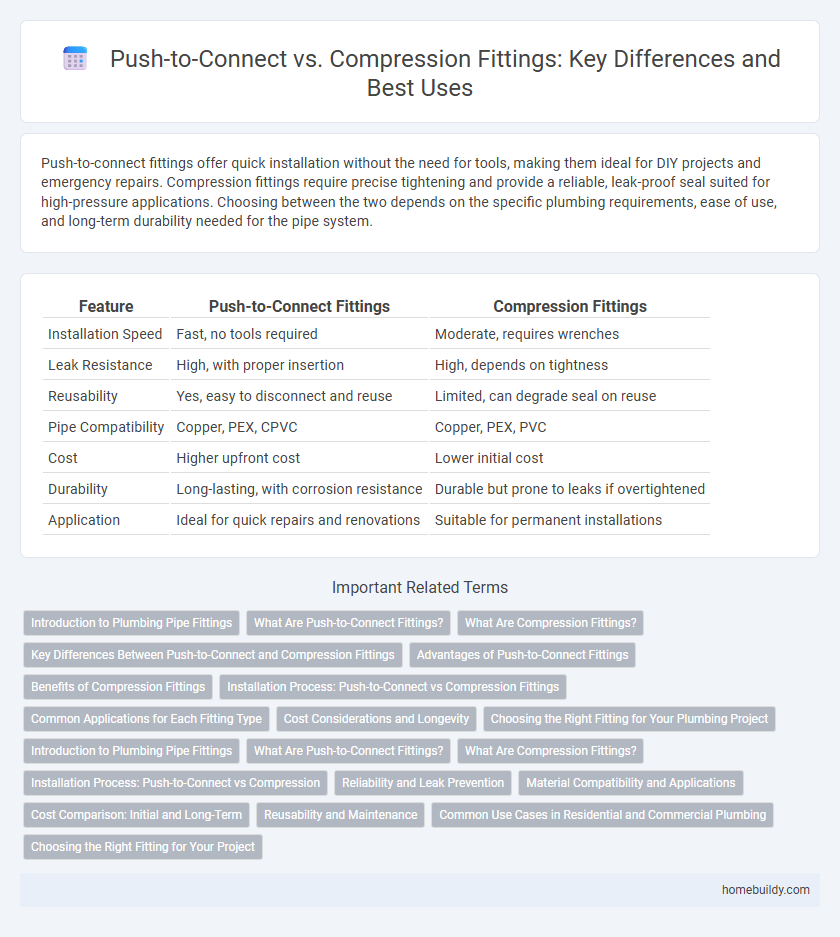Push-to-connect fittings offer quick installation without the need for tools, making them ideal for DIY projects and emergency repairs. Compression fittings require precise tightening and provide a reliable, leak-proof seal suited for high-pressure applications. Choosing between the two depends on the specific plumbing requirements, ease of use, and long-term durability needed for the pipe system.
Table of Comparison
| Feature | Push-to-Connect Fittings | Compression Fittings |
|---|---|---|
| Installation Speed | Fast, no tools required | Moderate, requires wrenches |
| Leak Resistance | High, with proper insertion | High, depends on tightness |
| Reusability | Yes, easy to disconnect and reuse | Limited, can degrade seal on reuse |
| Pipe Compatibility | Copper, PEX, CPVC | Copper, PEX, PVC |
| Cost | Higher upfront cost | Lower initial cost |
| Durability | Long-lasting, with corrosion resistance | Durable but prone to leaks if overtightened |
| Application | Ideal for quick repairs and renovations | Suitable for permanent installations |
Introduction to Plumbing Pipe Fittings
Push-to-connect and compression fittings are essential for secure plumbing pipe connections, offering distinct installation methods and compatibility with various pipe materials. Push-to-connect fittings enable quick, tool-free assembly by simply pushing the pipe into the fitting, ideal for copper, PEX, and CPVC pipes. Compression fittings utilize a threaded nut and ferrule to create a watertight seal, commonly used in metal and plastic pipes where disassembly may be required for maintenance.
What Are Push-to-Connect Fittings?
Push-to-connect fittings are a type of plumbing connector designed for quick and secure pipe joining without the need for soldering, clamps, or glue. These fittings use an internal O-ring and a gripping mechanism to create a watertight seal when a pipe is pushed into the fitting. Compatible with various materials like copper, PEX, and CPVC, push-to-connect fittings offer ease of installation and reliable performance in both residential and commercial plumbing systems.
What Are Compression Fittings?
Compression fittings are mechanical connectors used in plumbing to join pipes or tubes without soldering, involving a compression nut, ring (ferrule), and a fitting body. They create a watertight seal by compressing the ferrule against the pipe as the nut is tightened, making them suitable for metal and plastic pipes. Commonly used in water supply lines and gas connections, compression fittings offer reliability, ease of installation, and maintenance without requiring heat or special tools.
Key Differences Between Push-to-Connect and Compression Fittings
Push-to-connect fittings offer quick, tool-free installation by simply pushing the pipe into the fitting, making them ideal for DIY and emergency repairs, while compression fittings rely on a threaded nut and ferrule to create a watertight seal, requiring wrenches for tightening. Push-to-connect fittings are reusable and generally more forgiving in alignment, but compression fittings provide a stronger, more secure connection suitable for high-pressure applications. Material compatibility also differs, with push-to-connect fittings commonly used with PEX, CPVC, and copper pipes, whereas compression fittings can accommodate various metal and plastic pipes.
Advantages of Push-to-Connect Fittings
Push-to-connect fittings offer significant advantages over compression fittings, including faster and easier installation without the need for specialized tools or soldering. These fittings provide a secure, leak-proof seal with minimal effort, reducing the risk of user error and improving reliability in plumbing systems. Their compatibility with a variety of pipe materials, such as copper, PEX, and CPVC, enhances versatility and convenience for both professional plumbers and DIY enthusiasts.
Benefits of Compression Fittings
Compression fittings offer a reliable, leak-resistant seal ideal for high-pressure plumbing applications without requiring special tools or heat. They provide easy installation and maintenance, allowing for quick disassembly and reassembly in tight spaces, which is beneficial for repair and modification tasks. The durable metal construction ensures long-term performance and compatibility with various pipe materials, making compression fittings a versatile choice for plumbing systems.
Installation Process: Push-to-Connect vs Compression Fittings
Push-to-connect fittings offer a faster installation process by simply pushing the pipe into the fitting, requiring no special tools or soldering, which significantly reduces labor time. Compression fittings involve tightening a threaded nut around a compression ring and pipe, necessitating precise alignment and the use of wrenches to ensure a secure, leak-free connection. The push-to-connect method is ideal for quick repairs and DIY projects, while compression fittings provide a reliable, durable seal suited for high-pressure plumbing systems.
Common Applications for Each Fitting Type
Push-to-connect fittings are commonly used in residential plumbing for quick repairs and retrofits on copper, PEX, and CPVC pipes due to their ease of installation without specialized tools. Compression fittings are preferred in high-pressure applications and metal piping systems, such as water supply lines and gas connections, where a secure, leak-resistant seal is essential. Both fitting types provide reliable options, with push-to-connect favored for speed and convenience, and compression fittings chosen for durability and traditional pipe materials.
Cost Considerations and Longevity
Push-to-connect fittings generally have a higher upfront cost compared to compression fittings but offer significant savings in labor time and ease of installation. Compression fittings tend to be more affordable initially but may require periodic maintenance or replacements due to potential leaks over time. Longevity-wise, push-to-connect fittings provide durable, leak-resistant connections ideal for long-term use, while compression fittings might have a shorter lifespan under high-pressure or temperature fluctuations.
Choosing the Right Fitting for Your Plumbing Project
Push-to-connect fittings offer quick, tool-free installation and are ideal for DIY projects and repairs, providing secure, leak-free connections for copper, CPVC, and PEX pipes. Compression fittings deliver durable, tight seals suitable for high-pressure applications and require precise tightening with tools, making them better for professional plumbers or projects needing long-term reliability. Selecting the right fitting depends on factors like pipe type, pressure requirements, installation speed, and project scale to ensure optimal performance and durability.
Push-to-connect vs Compression fittings Infographic

 homebuildy.com
homebuildy.com